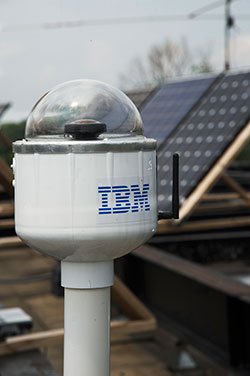
Renewable energy forecasting is a major challenge for power generators around the world.
An IBM research programme partly funded by the US Department of Energy SunShot Initiative is seeking to change this. Taking advantage of IBM’s Watson cognitive computing platform the press release claims that the ability to accurately forecast wind and solar have increased by as much as 30%.
Renewable energy need accurate forecasts to deliver real benefits
One of the big challenges facing energy companies who want to increase their use of renewable energy is getting a realistic forecast of generating capability. Without this, there is a need to keep other generating capabilities online in case the energy from renewables falls below predictions.
For example, it might be reasonable to assume that as long as a solar panel has sunlight, it can generate power. The problem here is not the amount of sun but the operating temperature of the solar panels. Experiments in the UK and Nigeria have shown that as the panels heat up they lose their effectiveness. For every degree above 42 Celsius, solar panels lose 1.1% of their effectiveness. In the south west United States that could have significant impact on generating capacity.
Wind can also be similarly affected. The size of the turbine blades means different operating envelopes. It takes time to turn on/off a turbine and for it to begin to effectively generate energy. Having highly accurate models and forecasts of wind flow will reduce the time that the turbines are not generating energy.
A big data exercise
To improve the quality of the forecasts, IBM used its cognitive computing engine known as Watson. Large quantities of historical forecasts and real data were ingested by the system and then remodelled. This provided Watson with the ability to understand how the weather sensor network was reporting data and what was required to interpret it.
Using Watson is an ongoing process. As new data arrives it is added to the corpus of information held. Using machine learning and the cognitive capabilities of Watson, models can be continuously adjusted and weather forecasts can be delivered that are focused on smaller areas. This allows for the problem of micro climates and localised weather systems to be accommodated.
“By continuously training itself using historical records from thousands of weather stations and real time measurements, IBM’s system combines predictions from a number of weather models with geographic information and other data to produce the most accurate forecasts — from minutes to weeks ahead,” explained Dr. Siyuan Lu, Physical Analytics Researcher at IBM.
Renewable energy generation is not just about big installations
In the US as in many other countries, renewable energy is not just about large installations. There are many home owners, small and large businesses that have invested in renewable energy. What they don’t require, they feed back into the grid and get paid for. Similarly, when their generating ability falls below their needs, they take energy out of the grid.
This means that energy companies need to now only model the impact on their own renewable grids but also incorporate data from a wide spread of sources. In the case of solar, this can mean hundreds of thousands of homes. For power companies and government departments responsible for paying subsidies to those pushing power back to the grid, there is a greater financial impact than just how much energy is being generated.
Conclusion
It will be interesting to see how quickly IBM begins to widen the scope of this research. In the UK, for example, there are concerns that recent reductions to subsidies will have a negative impact on future investment in renewables. This would have a serious impact on the ability of the UK to meet its obligations to carbon reduction as demanded by the European Commission.
There will also be interest from large data centres and technologies companies who have been building out their renewable generating capacity.


























